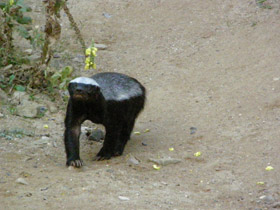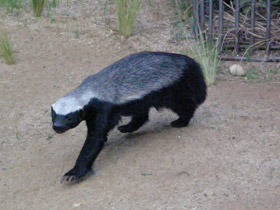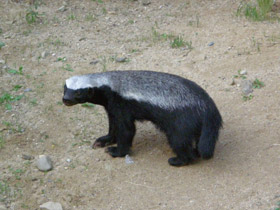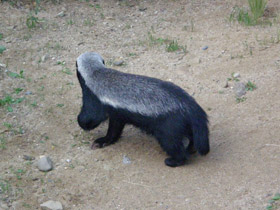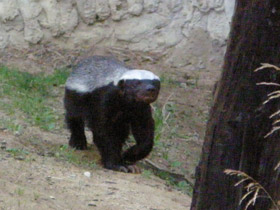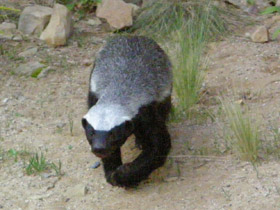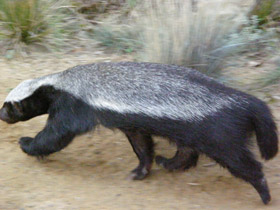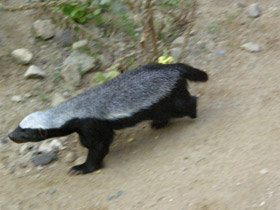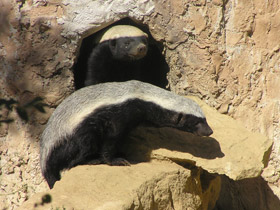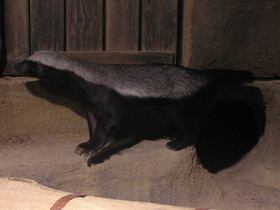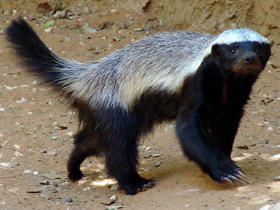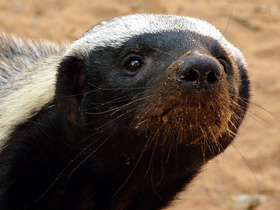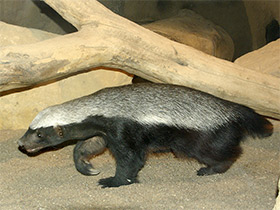The honey badger or the ratel (Mellivora capensis)
Honey badger видео
The honey badger (Mellivora capensis), also known as the ratel (/ˈrɑːtəl/ or /ˈreɪtəl/), is a mammal widely distributed in Africa, Southwest Asia, and the Indian subcontinent. Because of its wide range and occurrence in a variety of habitats, it is listed as Least Concern on the IUCN Red List.
It is the only living species in the genus Mellivora and in the mustelid subfamily Mellivorinae. Despite its name, the honey badger does not closely resemble other badger species; instead, it bears more anatomical similarities to weasels. It is primarily a carnivorous species and has few natural predators because of its thick skin, strength and ferocious defensive abilities.
Taxonomy
Viverra capensis was the scientific name used by Johann Christian Daniel von Schreber in 1777 who described a honey badger skin from the Cape of Good Hope. Mellivorae was proposed as name for the genus by Gottlieb Conrad Christian Storr in 1780. Mellivorina was proposed as a tribe name by John Edward Gray in 1865.
The honey badger is the only species of the genus Mellivora. Although in the 1860s it was assigned to the badger subfamily, the Melinae, it is now generally agreed that it bears few similarities to the Melinae. It is much more closely related to the marten subfamily, Guloninae, and furthermore is assigned its own subfamily, Mellivorinae. Differences between Mellivorinae and Guloninae include differences in their dentition formulae. Though not in the same subfamily as the wolverines, which are a genus of large-sized and atypical Guloninae, the honey badger can be regarded as another, analogous, form of outsized weasel or polecat.
Habitat
Mellivora capensis is a species of carnivorous mammal of the family Mustelidae native to Africa, the Middle East and the Indian subcontinent. It is the only extant species of its genus and subfamily (Mellivorinae).
Mellivora capensis is a small carnivore, the only member of its genus. It is so named because it loves to gorge itself on honey, although it makes relatively rare forays into wild bee colonies and feeds mainly on various mammals.
Mellivora capensis is found in Africa and Asia. In Africa, it is found almost everywhere from the Arabian Peninsula to Central Asia, as well as in India and Nepal. Mellivora capensis lives in various climatic zones, including steppes, forests and mountainous areas, avoiding only regions that are too hot or too humid, such as deserts or tropical forests.
Appearance
The adult Mellivora capensis weighs an average of 9-12 kg and has a body length of 70-80 cm (excluding the 25 cm tail). Externally it resembles a badger with its elongated body and short, muscular legs. However, unlike the badger, Mellivora capensis has a blunt muzzle, no ear flaps, 4-5 cm curved claws on the forelegs and a very elastic and thick skin, up to 6 mm thick on the neck. Its colouring is contrasting: the entire lower part of its body, including the limbs, is covered with shiny black fur, while the upper part of the head, the back and the sides are greyish white.
Lifestyle and peculiarities
Mellivora capensis digs a burrow 1 to 3 m long, which ends in a small chamber without a bed. It can dig a shelter in about 10 minutes with its strong legs. It sometimes occupies the burrows of other animals and also inhabits rock crevices and even tree hollows.
Mellivora capensis usually have several burrows in their territory and, as they travel long distances during the day, they rarely spend two nights in the same place. They are mainly active at dusk and at night, but can also be seen during the day in cool weather.
Mellivora capensis are known to be remarkably fearless and sometimes aggressive animals. Their thick fur, powerful jaws and claws serve as effective defensive tools against enemies. The Mellivora capensis has a very unusual reaction to venomous snakebites, with convulsions and death, in which case it recovers after 20-40 minutes and returns to normal life.
In addition, the beast, like a skunk, has glands that exude a foul smell. Mellivora capensis will attack even larger animals if threatened.
Nutrition
This predator feeds on all types of prey, from turtles, venomous and non-venomous snakes and small crocodiles to various insects (locusts, termites), spiders and scorpions. The diet of Mellivora capensis also includes various rodents, offspring of larger species such as foxes or antelopes, birds and their eggs, as well as amphibians and carrion. Mellivora capensis occasionally eats berries and fruits. It moves along the ground in search of food, but sometimes also climbs trees, especially when it wants to reach honey. Mellivora capensis has a very acute sense of smell, which helps it to find prey when they are hidden underground, which it will quickly dig up.
Social behaviour and reproduction
Mellivora capensis lives in isolation for most of the year. The female's pregnancy lasts about 7 months, after which 1-2 young are born naked and helpless. The female constantly carries them from one burrow to another for safety. After a month, the young open their eyes, but it is not until three months that they begin to emerge from the burrow. Young Mellivora capensis spend about a year with their mother.
Subspecies
There are 12 known subspecies of ratel:
- Mellivora capensis capensis capensis;
- Mellivora capensis abyssinica;
- Mellivora capensis buechneri;
- Mellivora capensis concisa;
- Mellivora capensis cottoni;
- Mellivora capensis inaurita;
- Mellivora capensis indica;
- Mellivora capensis leuconota;
- Mellivora capensis maxwelli;
- Mellivora capensis pumilio;
- Mellivora capensis signata;
- Mellivora capensis wilsoni.

















